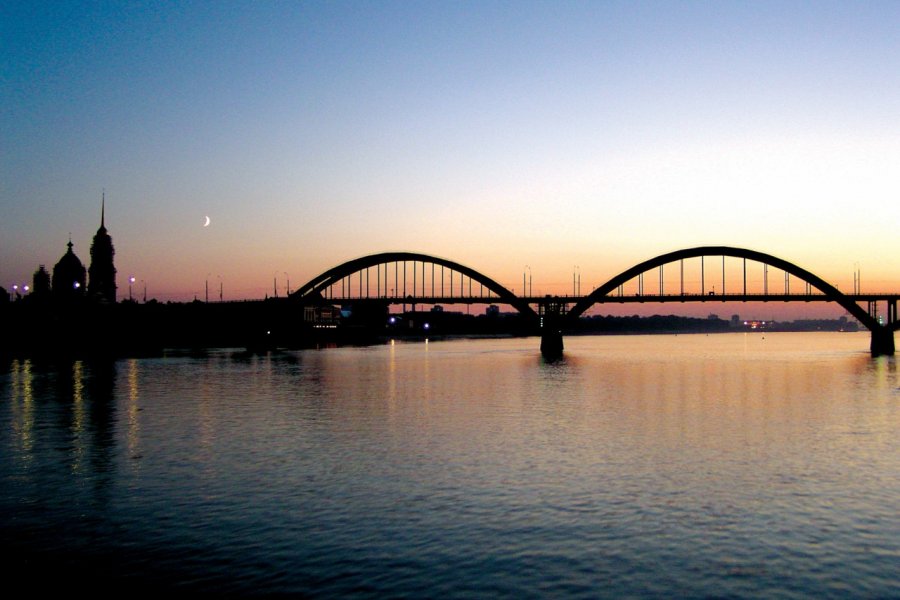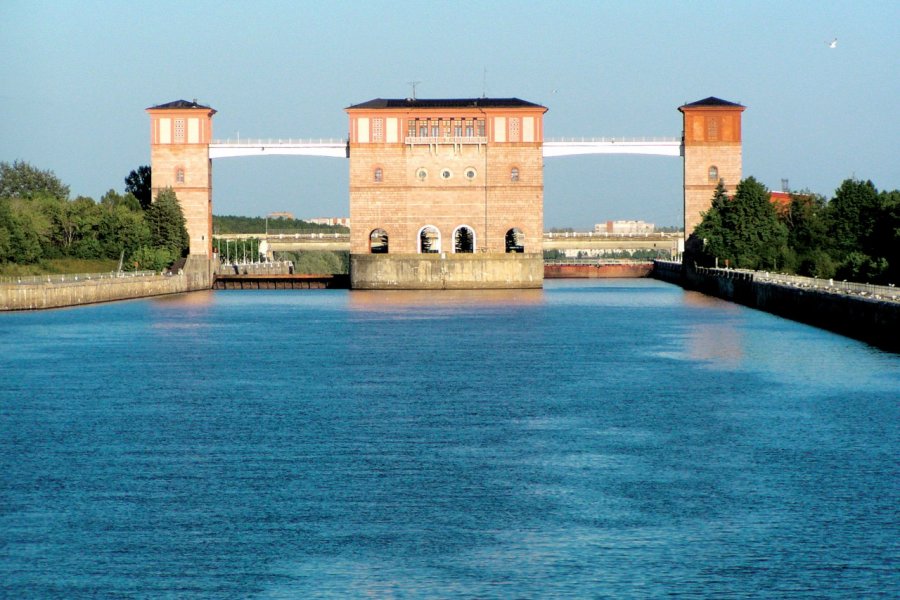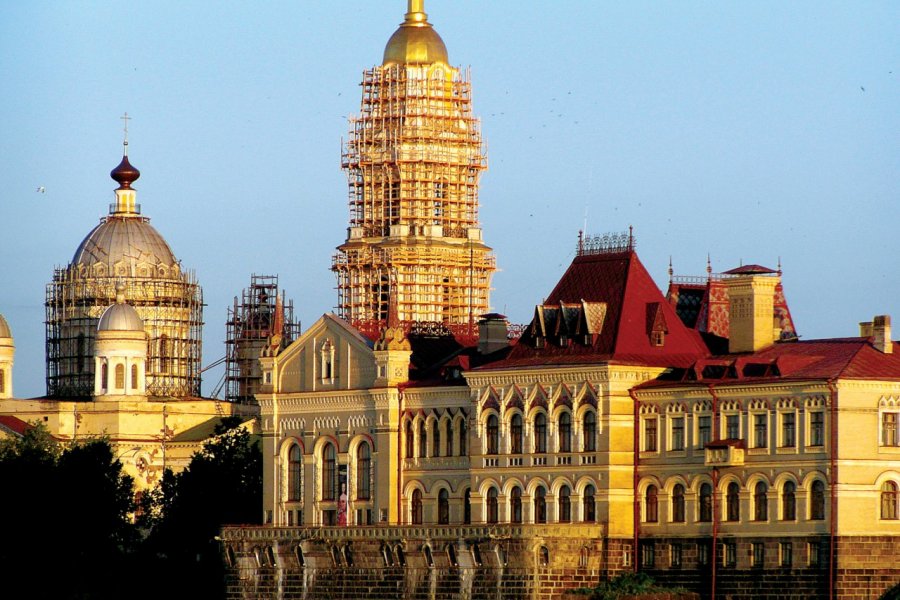Travel Guide Rybinsk (Рыбинск)
Find an accommodation
Advertising
The Volga Basin with its 1,360,000 km² is home to about 25% of the entire Russian population and well deserves its nickname of Mother Volga. Before the creation of the Rybinsk reservoir, the Volga was connected to other rivers by a network of streams, rivers and other artificial junctions. In the summer, the level of the streams, rivers and other artificial junctions decreased considerably, and like the Volga, there were enormous problems with navigation, which was particularly intensive at this time of year. As the locks of the Mariinskaya system were rather rudimentary, the boats were towed by rope and the journey time was endless: from Rybinsk it could take three months to reach St. Petersburg. At km 422. At the entrance to the Rybinsk hydroelectric power station, a statue is dedicated to Mother Volga. She holds out one arm as a sign of welcome and a manuscript in the other. At km 423. The ship slides under the bridge to the Rybinsk power station, one of the seven hydroelectric power stations on the Volga. Completed in 1950, it was one of Moscow's only sources of energy during the Second World War. It was its unfinished appearance that enabled it to escape the Luftwaffe bombings. When passing through locks No. 11 and No. 12, the ship descends 14 m. At km 425-440, the town of Rybinsk is visible. Its name, "city of fish", comes from the 12th century when it was a Slavic fishing centre, but it was officially founded in 1777 when Peter the Great's Mariinskaya system turned it into an important trading port. It was named Shcherbakov from 1946 to 1957 and then Andropov from 1984 to 1989. It is an industrial city, with its shipyards, flour mills, rope mills and match factory. It stretches over 15 km between the two banks of the Volga. The first contact is very romantic, since one sees, from the ship, the neoclassical cathedral of the Saviour-Transfiguration, its five domes, its baroque bell tower and its golden needle. Built in the 19th century, this cathedral could have been located on the St Isaac's Square in St Petersburg if its plan had not been rejected in favour of the current construction. The river terminal and its blue and white columns were built in 1811. Perched on the right bank is a 20th-century palace with German-style tiles and a 28-metre obelisk in honour of the victims of the Second World War. On the outskirts, a vast oil zone with its tankers, refineries and oil tanks provides an industrial landscape before giving way to natural landscapes. At km 480. We cross the town of Tutayev named after the hero of the Red Army. Founded in 1283 by the Prince of Yaroslavl, this town, which seems to have come out of a Russian tale, was called Romanov for a long time and flourished towards the end of the 18th century when its main activities were icon painting, shipbuilding, carpentry, weaving and goldsmithing. At that time, many churches were built. The cherry-coloured Church of the Exaltation of the Cross is perched on the shore. On the heights of the river, you will see the church of Kazan-de-la-Transfiguration with its white bell tower. On the other bank stands the Cathedral of the Ascension. Nowadays, the city attracts many artists who come to paint its old streets and wooden houses. At km 484. You can see the ruins of the Tikhvinskoye Castle, built in 1767 and considered one of the very first classical Russian-style buildings in the region. It was built by a certain Lushinin, a local aristocrat, who dreamed of welcoming Catherine II there on an official trip on the Volga River. At km 512. The Monastery of the Presentation of the Virgin or Tolga Convent lies on the left bank of the river in a deciduous forest. It consists of two main churches surrounded by walls whose towers are crowned with grey spires. The Cathedral of the Saviour is surmounted by 12 domes around a higher dome. The white stone cathedral of the introduction to the temple is surmounted by 5 green domes. The adjacent bell tower contains the largest bell cast by the craftsman Motoriev whose son later cast the Tsarina bell of the Moscow Kremlin. Founded at the beginning of the 14th century, when Prince David reigned over the land of Yaroslavl, it is one of the oldest in the region and houses an icon recognized as miraculous at the time: from the Virgin's eyes flowed holy oil that cured all the illnesses of the faithful. The history of this icon is very strange. A bishop returning from a village on the White Lake settles at the mouth of the Tolga River to spend the night when he is awakened by a fire burning on the other bank. A footbridge of fire allows him to go to the other side and discover the famous icon floating above the fire that he prays before returning by the same path. A church is therefore built there. After having prospered for a long time, the monastery was closed in 1926 by the Bolsheviks and then transformed into a camp for education through work. In 1988, it was returned to the Orthodox Church, which restored it and transformed it into a convent. Navigation on the Volga River to Kostroma is so deep, wide and easy that navigators have nicknamed it "the tea part of the journey".
Suggested addresses Rybinsk (Рыбинск)
Weather at the moment
Advertising
Organize your trip with our partners Rybinsk (Рыбинск)
Transportation
Book your plane tickets
Car Rental
Boat rental
Accommodation & stays
Find a hotel
Holiday rental
Find your campsite
Tailor-made trip
Immersion travel
Services / On site
Activities & visits
Find a doctor






